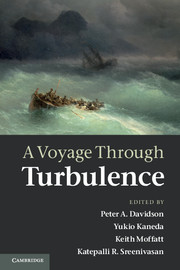Book contents
- Frontmatter
- Contents
- List of contributors
- Preface
- 1 Osborne Reynolds: a turbulent life
- 2 Prandtl and the Göttingen school
- 3 Theodore von Kármán
- 4 G.I. Taylor: the inspiration behind the Cambridge school
- 5 Lewis Fry Richardson
- 6 The Russian school
- 7 Stanley Corrsin
- 8 George Batchelor: the post-war renaissance of research in turbulence
- 9 A.A. Townsend
- 10 Robert H. Kraichnan
- 11 Satish Dhawan
- 12 Philip G. Saffman
- 13 Epilogue: a turbulence timeline
- References
7 - Stanley Corrsin
Published online by Cambridge University Press: 07 October 2011
- Frontmatter
- Contents
- List of contributors
- Preface
- 1 Osborne Reynolds: a turbulent life
- 2 Prandtl and the Göttingen school
- 3 Theodore von Kármán
- 4 G.I. Taylor: the inspiration behind the Cambridge school
- 5 Lewis Fry Richardson
- 6 The Russian school
- 7 Stanley Corrsin
- 8 George Batchelor: the post-war renaissance of research in turbulence
- 9 A.A. Townsend
- 10 Robert H. Kraichnan
- 11 Satish Dhawan
- 12 Philip G. Saffman
- 13 Epilogue: a turbulence timeline
- References
Summary
Early years
On 3 April 1920, a few years after G.I. Taylor's far-reaching observations of turbulent diffusion aboard the SS Scotia (Taylor, 1921), and at the time Lewis Fry Richardson was imagining vast weather simulations of atmospheric flow by human ‘computers’ (Richardson, 1922), across the Atlantic in the city of Philadelphia, Stanley Corrsin was born. His parents, Anna Corrsin (née Schorr) and Herman Corrsin had both emigrated to the United States only 13 years before. They came from Romania, where many Russian Jews had settled after leaving Russia in the late 19th and early 20th century. Following further hostilities in Romania, many emigrated again, this time to America. Anna and Herman Corrsin arrived separately at Ellis Island in 1907, Anna in July, and Herman in October. After brief stays in the New York and New Jersey area, where they met and married in 1912, they settled in the city of Philadelphia, in a mixed middle-class neighborhood, not far from the University of Philadelphia. They went into business in the clothing industry and raised their children. Their first son Eugene died young and their second, Lester, was born in 1918. Stan was their third and youngest son.
As a child, Stan Corrsin attended school in Philadelphia and, showing early signs of a highly gifted analytical mind, went on to skip two grades. He enjoyed following the ups and downs of his favorite baseball team, the Philadelphia Athletics.
- Type
- Chapter
- Information
- A Voyage Through Turbulence , pp. 238 - 275Publisher: Cambridge University PressPrint publication year: 2011
References
- 1
- Cited by



